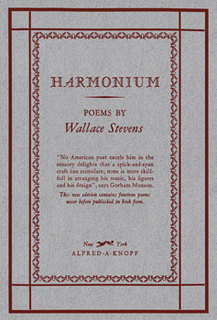Related Research Articles

The Pulitzer Prize for Poetry is one of the seven American Pulitzer Prizes awarded annually for Letters, Drama, and Music. It first presented in 1922 for a distinguished volume of original verse by an American author, published during the preceding calendar year.

Wallace Stevens was an American modernist poet. He was born in Reading, Pennsylvania, educated at Harvard and then New York Law School, and he spent most of his life working as an executive for an insurance company in Hartford, Connecticut. He won the Pulitzer Prize for Poetry for his Collected Poems in 1955.

Jorge Agustín Nicolás Ruiz de Santayana y Borrás, known in English as George Santayana, was a philosopher, essayist, poet, and novelist. Originally from Spain, Santayana was raised and educated in the US from the age of eight and identified himself as an American, although he always retained a valid Spanish passport. He wrote in English and is generally considered an American man of letters. At the age of 48, Santayana left his position at Harvard and returned to Europe permanently.

Harmonium is a book of poetry by American poet Wallace Stevens. His first book at the age of forty-four, it was published in 1923 by Knopf in an edition of 1500 copies. This collection comprises 85 poems, ranging in length from just a few lines to several hundred. Harmonium was reissued in 1931 with three poems omitted and fourteen new poems added.
"The Worms at Heaven's Gate" is a poem from Wallace Stevens' first book of poetry, Harmonium (1923). It was first published in 1916 and is therefore in the public domain.
Metaphysical naturalism is a philosophical worldview which holds that there is nothing but natural elements, principles, and relations of the kind studied by the natural sciences. Methodological naturalism is a philosophical basis for science, for which metaphysical naturalism provides only one possible ontological foundation. Broadly, the corresponding theological perspective is religious naturalism or spiritual naturalism. More specifically, metaphysical naturalism rejects the supernatural concepts and explanations that are part of many religions.
"The Emperor of Ice-Cream" is a poem from Wallace Stevens's first collection of poetry, Harmonium. It was first published in 1922, and is in the public domain. Stevens' biographer, Paul Mariani, identifies the poem as one of Stevens' personal favorites from the Harmonium collection. The poem "wears a deliberately commonplace costume", he wrote in a letter, "and yet seems to me to contain something of the essential gaudiness of poetry; that is the reason why I like it".
"Le Monocle de Mon Oncle" is a poem from Wallace Stevens's first book of poetry, Harmonium. It was first published in 1918.
"Homunculus et la Belle Etoile" is a poem from Wallace Stevens's first book of poetry, Harmonium. It was first published in 1919.
"Invective Against Swans" is a poem by Wallace Stevens from his first book of poetry, Harmonium (1923).
"The Comedian as the Letter C" is a poem from Wallace Stevens's first book of poetry, Harmonium (1923). It was one of the few poems first published in that collection and the last written for it. John Gould Fletcher frames the poem as expressing Stevens's view "that the artist can do nothing else but select out of life the elements to form a 'fictive' or fictitious reality."
"Last Looks at the Lilacs" is a poem from Wallace Stevens's first book of poetry, Harmonium. It was first published in 1923.
"Life is Motion" is a poem from Wallace Stevens's first book of poetry, Harmonium. It was first published in 1919, so it is in the public domain.
"To the One of Fictive Music" is a poem from Wallace Stevens's first book of poetry, Harmonium. First published in 1922, it is in the public domain.
"Lunar Paraphrase" is a poem from the second (1931) edition of Wallace Stevens's first book of poetry, Harmonium. One of Stevens's "war poems" from "Lettres d'un Soldat" (1918), it is in the public domain.
"Anatomy of Monotony" is a poem from the second edition (1931) of Wallace Stevens's first book of poetry, Harmonium. Unlike most of the poems in this collection, it was first published in 1931, so it is restricted by copyright until 2025 in America and similar jurisdictions, because of legislation like the Sonny Bono Copyright Term Extension Act. However, it is quoted here in full, as justified by fair use for the purpose of scholarly commentary.
"Tea" is a poem from Wallace Stevens' first book of poetry, Harmonium. It was first published in 1915 in the journal Rogue, so it is in the public domain.

Shabda Brahman or Sabda-brahman or Nada brahman means transcendental sound or sound vibration or the transcendental sound of the Vedas or of Vedic scriptures.
References
- Buttel, Robert. Wallace Stevens: The Making of Harmonium. 1967: Princeton University Press.
- Stevens, Holly. Letters of Wallace Stevens. 1966: University of California Press.